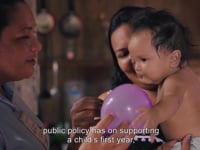3.3 Advancing child and family friendly policies
Investing in early childhood development is good for everyone – governments, businesses, communities, parents and caregivers, and most of all, babies and young children. It is also the right thing to do, helping every child realize the right to survive and thrive” (WHO, 2018, p.1).
Family life is enormously affected, directly and indirectly, by public policies. Policies on matters such as immunizations/growth monitoring and safe birth, parental leave, workplace childcare, support for breastfeeding, free and accessible quality education, and access to ECD programs make a huge difference in the daily lives of children and families.
Consider…Maria and Esther Twenty-two-year-old Maria lives with her husband and their two-year-old son, Javier…..Esther and her husband welcome their new daughter, a sister for their two-year-old son, Nelson. …Read more
What are the significant differences in the experiences of these two families?
How have these differences impacted on the parents?
How do you expect they will impact on the children?
What role might country policies play on the families’ differing experiences?
Now watch a short clip from the Bernard van Leer Foundation’s The Beginning of Life documentary that looks at how both listening to families and science are vital for progressive child and family-friendly policies and better for societies.
There is a sense that the policy landscape for early child development is changing for the better, at least in some parts of the world. This may be because the evidence that investment in the first 2000 days after conception makes a big difference for children, families, and societies is so clear and incontrovertible.
Dr. Jody Heymann, distinguished professor and former dean of the UCLA Fielding School of Public Health, founded the WORLD Policy Analysis Center. Explore WORLD’s website to learn more about their focus on global data regarding policies that affect family life, especially working families. Watch WORLD’s video to hear Heymann explain why “data matters” and how it can be used to advance policies around the world.
Heymann uses parental leave as an example of how data, particularly when displayed in a visual and engaging manner, has inspired countries to make important policy changes. Watch as Heymann discusses some of the challenges of policies that support parenting and what a difference effective policies would make in parents’ and children’s lives.
Heymann goes on to discuss circumstances that force parents to provide less than optimal care for their children, through no fault of their own.
The following link is to several slides from Heymann’s 2015 presentation that included global maps highlighting data on paid parental leave, breastfeeding breaks, and parental leave for children’s health needs.
Was there anything on these slides that surprised you?
What are some of the policies, in your context, that support working families?
Do the policies support working fathers as well as working mothers?
Read about four recommended sets of family-friendly policies for workplaces in the following policy brief.
The following two video clips show parents and experts from different parts of the world, discussing pregnancy experiences and different kinds of parental leave.
According to the first Bernard Van Leer video, what do pregnant women need?
What kind of policies support pregnant women where you live?
WORLD gathers and analyzes information on countries’ laws, policies, and programs that affect human development and wellbeing. Explore the global maps on topics such as education, gender, disability, health, and climate.
What did you learn about policies in your country?
What did you learn about policies or programs in other countries?
Data is typically presented in tables or graphs. What do you see as the added value of WORLD’s interactive maps?
In the video that you watched earlier on this page, Heymann’s message is that “data matters” – so “use it”. How can you use data to advance child and family friendly policies in your context?
Policymaking to support nurturing care
If you are doing nothing, do something.
If you are doing a little, do more.
If you are doing a lot, do better” (Marmot, M., 2016)
The Nurturing Care Framework for Early Child Development set out to provide a roadmap for governments to provide child and family-friendly policies that support nurturing care. By now you are familiar with some of the key concepts of the NCF.
Chapter 4 of the NCF outlines five strategic actions governments should take to improve the wellbeing of young children. Each of the strategic actions has five specific proposed actions to be taken at the country level. As you read, think about your own context.
Overall, in the big picture, where do you see your country in relation to the 5 strategic actions? Are there areas in which you feel there has been progress and impact?
For each strategic action, would you say your national government is already taking action, aware but not acting yet, or unaware?
Are there systems in place that could help operationalize or expedite these actions?
Is the political environment, including public awareness, amenable to these actions?
Test your memory of the five strategic actions in the next interactive activity.
Countries around the world are supporting nurturing care in a variety of ways and sharing and learning from others can provide inspiration. Learn about some of these examples, as they relate to the strategic actions. The following webpage provides examples of countries in each category.
What inspires you in these country examples?
There are more examples related to some strategic actions in the Nurturing Care Framework than others. Why do you think that is?
The next reading, from the Harvard Centre for the Developing Child, focuses on using science to inform policies that affect young children.
The paper describes three clear, evidence-based design principles that must be considered when trying to establish policies that really improve outcomes for children and families. Looking back at the scenario at the beginning of this page, which of the design principles do you see in action in each scenario and which are missing?
Reaching all children and families
Policies for early child development must be for all children, including children with disabilities. Listen as Tendai Mtana, former executive secretary of Education and Children, Mombasa County, Kenya, describes a variety of factors that create challenges in providing inclusive education.
The following is a section from the WHO discussion paper “Early Childhood Development and Disability”.
The discussion paper suggests that a twin-track approach is needed to best support the development of young children with disabilities. Is this approach common in your country or community?
Are children with disabilities commonly considered in planning and included in programs for young children where you live? Why or why not?
Do ECD and disability advocates work together or separately in your experience?
As child mortality rates are reduced, more children with disabilities survive. Are they generally able to get the support they need?
The thinking embodied in the Nurturing Care Framework and in other influential reports has evolved over time. The 2008 WHO Commission on the Social Determinants of Health, chaired by Sir Michael Marmot, helped us understand that human health is mostly affected by our social circumstances. Social circumstances such as poverty, isolation, prejudice, stress, and other pressures can take a significant toll on health and even on lifespan.
In the next clip, Sir Michael Marmot describes the recommendations from the WHO Report of the Commission on the Social Determinants of Health, specifically the need for governments to acknowledge the central issue of social justice and take steps to develop and implement policies and programs that support it.
Social and economic change is happening quickly in some parts of the world. In the next clip, Dr. Alex Awiti, founder and director of the East Africa Institute at the Aga Khan University, Nairobi, talks about the pressure on politicians and policymakers to meet the expectations of a rising middle class in Africa.
What does Marmot mean when he says we must put social justice at the core of all policies?
Awiti’s comments are about social and economic changes that have produced a new narrative and put pressure on policymakers in Africa. How does this relate to what Marmot means by a ‘social movement’ to change public social policies?
To what extent do you think social justice is reflected in the policies affecting health in general and children in particular in your country?
Has your country changed much since the WHO report was published in 2004? Is there a ‘new narrative’ that should be reflected in policies?
Interesting and inspirational examples of child and family-friendly policies come from all over the world. Brazil has recently taken major steps to support social equity through ECD on a very large scale by implementing Criança Feliz (Happy Parenting). Maria and Javier, in the example above, are benefitting from the Criança Feliz program.
The following video shows Criança Feliz in action and its impact on some families.
Another innovative example, on a municipal level, comes from China. The city of Shenzen, with a population of over 12 million, is one of many megacities in China that have grown rapidly and on an enormous scale. Recently they have committed to working with a range of stakeholders to transform Shenzen into a much more child-friendly city.
We will end the module with the story of how one boy struggled to get a primary school education in Kenya before the country policy changed and how he is managing to “give back” so that other impoverished children have a chance to learn. Nehemia Ndeta is the program director at the Kwa Kototo Centre and School in Kenya.
The United Nations recognizes the importance of family-friendly policies.
Sir Michael Marmot discusses how putting points out examples of such commitment from the state of Kerala in India and Costa Rica.
The following paper looks at how early childhood policy has evolved in several countries between 2000 and 2015.
The final reading discusses how policies cannot be separated from cultural contexts.



